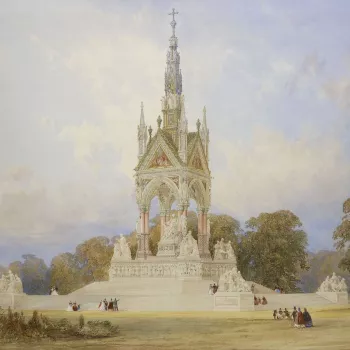Memorialising Albert
Explore how Albert was memorialised across art forms

Queen Victoria and Prince Albert's marriage lasted 21 years until his untimely death in 1861. The months preceding Albert's death were marked by domestic and international crises. The royal couple's eldest son, Bertie, had an affair with the Irish actress Nellie Clifden. This caused Victoria and Albert significant personal distress. In 1861, civil war had broken out between the United Federal States of the North and the Confederate States of the South. Britain's neutrality was threatened when the captain of the USS San Jacinto ordered the arrest of two Confederate envoys sailing on board RMS Trent, a British mail ship.
The British claimed this act was a violation of international law. On 30 November 1861, the Foreign Minister, Lord John Russell, sent Queen Victoria a draft of a memorandum to Abraham Lincoln, complaining strongly about the actions of the Federal government. Prince Albert intervened on 1 December 1861, despite his failing health. Albert modified the tone of the memorandum, and suggested that freeing the envoys and making a suitable apology would halt the crisis. Albert's actions were successful and the risk of war between Britain and America was averted. The successful resolution of the Trent affair was Albert's last great diplomatic contribution, before he finally succumbed to typhoid fever on 14 December 1861.
Writing to her uncle Leopold, less than a week after Albert's death, Victoria expressed her desire to honour Albert's wishes as if he were still alive:
If I must live on (and I will do nothing to make me worse than I am), it is henceforth for our poor fatherless children - for my unhappy country, which has lost all in losing him - and in only doing what I know and feel he would wish, for he is near me - his spirit will guide and inspire me!
Letters from Queen Victoria to King Leopold I of the Belgians. 12th July-24th December 1861, RA VIC/MAIN/Y/107/28
Throughout their lives together, Victoria and Albert collected and commissioned art to celebrate their relationship, family and shared history. In her enduring grief, Victoria continued this tradition, regularly commissioning new artworks and objects that memorialised Albert. Victoria instructed that Albert’s private rooms at royal residences be preserved and documented, and initiated the creation of the mausoleum at Frogmore and the Albert Memorial Chapel at Windsor. Prince Albert was also commemorated by many public sculptures in Britain and internationally.
The act of collecting perpetuates personal and cultural memory and Victoria continued a number of Albert’s album series and projects after his death. Albert’s influence can also be seen in photograph albums compiled by his children, who continued to experiment with photography following Albert's encouragement to practice this new medium. Prince Albert embraced the potential of new technologies to facilitate access to art and knowledge for personal enjoyment and learning. The ambition of the Prince Albert Digitisation Project to use the latest available technologies to unite selected papers, prints and photographs online for the first time, is in keeping with Albert’s original ethos.














